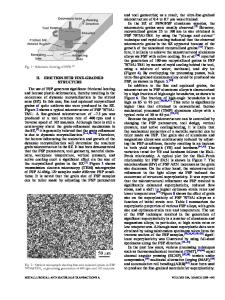A Review on Friction Stir Processing of Titanium Alloy: Characterization, Method, Microstructure, Properties
- PDF / 12,679,006 Bytes
- 29 Pages / 593.972 x 792 pts Page_size
- 106 Downloads / 367 Views
I.
INTRODUCTION
TITANIUM and its alloys have been in service among various industries because of their outstanding properties such as good mechanical performance, superior corrosion resistance and biocompatibility when compared with other metallic materials.[1,2] Actually, titanium and its alloys have become one of the most commonly used light alloys in industries that are more sensitive to performance than material cost.[3] However, titanium alloys present certain disadvantages in service. For example, as biomedical material, titanium alloy may present poor surface wear properties that will limit the performance and service life.[2] In addition, tiny particles on the surface will peel off as surface corrosion aggravates, which results in worse inflammation in soft tissues.[4,5] Another example is Ti-based shape memory alloys. Although most Ti-based shape memory alloys, such as TiNb, have a superior shape memory effect,
ZIHAO DING and LIQIANG WANG are with the State Key Laboratory of Metal Matrix Composites, School of Material Science and Engineering, Shanghai Jiao Tong University, Shanghai, 200240, China. Contact e-mail: [email protected] QING FAN is with the Department of Pediatric Orthopaedics, Xinhua Hospital Affiliated to Shanghai Jiaotong University School of Medicine, Shanghai 200092, China. Manuscript submitted March 28, 2019. Zihao Ding and Qing Fan contribute equally to this paper.
METALLURGICAL AND MATERIALS TRANSACTIONS B
pseudo-elasticity, corrosion resistance and biocompatibility, due to the difference in elastic modulus compared with human bones, their biomedical applications are still limited.[6–8] Therefore, appropriate measures are desired to realize control of both the microstructure and properties of titanium alloys to make them better meet requirements under various working environments. Friction stir processing (FSP) was derived from friction stir welding (FSW) proposed by The Welding Institute (TWI), which realizes soldering under solid state.[9,10] While FSW is intended to produce joints in titanium and its alloys, it is also capable of realizing surface modification of the material.[11,12] FSP can adjust and control the microstructure of materials, including eliminating defects, breaking dendrites and controlling fractions of the secondary phase without changing the overall component’s shape and size.[13] All these changes lead to the improvement of microhardness, strength, fatigue performance and corrosion resistance and finally improve its surface properties.[14] Because of the high quality, efficiency and reservation of materials’ original configuration, it is welcomed in the aerospace and automotive fields, for example.[15,16] Since it can be easily applied on various metals and alloys, it has become a hot spot of research in processing technology worldwide.[17] Generally speaking, FSP is an efficient solid-state processing solution that can offer localized surface modification.[18,19] Additionally, FSP is also able to introduce reinforcement particles (or second-phase particles) into raw mat
Data Loading...











